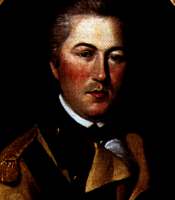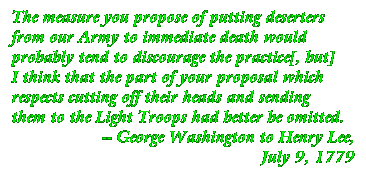


| [ Previous ] [ Next ] |

|
 By Charles Willson Peale |
Of the rebel cavalry officers, Harry Lee was most directly Banastre Tarleton's opposite number. Like Tarleton, Harry was an ambitious young officer, headlong and dashing on the field. If not for the outbreak of the war, he would have also been Banastre's school fellow. After his graduation from the College of New Jersey (now Princeton) in 1773, he was preparing to head off for the Middle Temple at roughly the same time Tarleton arrived there. But before he could sail, the colonial troubles flared towards open rebellion, and he found himself raising a troop of light cavalry instead of becoming a lawyer.
By 1778, he was in action, though his early career had its ups and downs. He received acclaim for several actions, but at one point he also faced a courtmartial on a long list of charges including reckless endangerment of his troops. Obviously, Harry was born to be a lawyer even if he missed his chance to study in England. He defended himself so well at his courtmartial that he was not only acquitted, he ended up with a Congressional medal.
Tarleton and Lee first butted heads on January 20, 1778, near Valley Forge. A British party commanded by Sir William Erskine, which included Captain Tarleton, attacked Lee's men at the Spread Eagle Tavern. Hoping to repeat his capture of Charles Lee, Ban led the charge -- but this time with less success. Harry sent him on his way with a wounded horse, a jacket full of buckshot and the loss of a helmet.
Lee was promoted to lieutenant colonel in late 1780, and shortly thereafter took "Lee's Partizan Corps" south to join Nathanael Greene's army.

|
He and Banastre met again frequently in 1781, as their units skirmishing around the edges of Greene's and Cornwallis's armies. It was during this period, on February 21, that Lee's men encountered a force of 600 Tories under the command of Colonel John Pyle (or Pile). Lee's Legion wore green uniforms that were extremely similar to those of Tarleton's British Legion, and the British Legion encampment was only a mile away. When green-coated dragoons rode into their midst, it was natural for the Tories to assume they were Tarleton's men. When they had Pyle's column essentially surrounded, Lee's Legion opened their attack, killing 90 Tories and wounding 150 more. Comments Bass, "The quality of Lee's mercy here was far worse than Tarleton's at the Waxhaws."1
A month later, on March 14, Tarleton and Lee clashed in advance of their armies near Guilford Courthouse. Banastre drove Lee's force into retreat, but paid for the victory. He was wounded by a rifle ball which later cost him half of his hand.
| [ Index ] | [ Previous ] [ Next ] |
1 Robert D. Bass, The Green Dragoon; The Lives of Banastre Tarleton and Mary Robinson (New York: Henry Holt and Company; 1957), p168. [ back ]
| Return to the Main Page | Last updated by the Webmaster on January 30, 2004 |